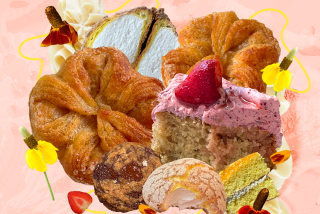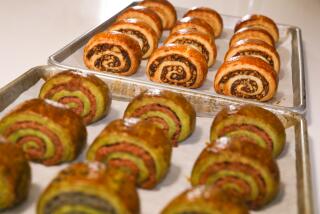A Small, Unique Act of Patriotism, With Cherry or Custard Filling
Late this summer my friend Jeanine Pereuil died. She had lived her entire 78 years in the same town in the valley of the Nivelle River, where whitewashed houses with red shutters cluster into villages, the pastures look like soft chartreuse pillows, the mountain crests like broken teeth, and the trout-filled river storms past rocky banks. It is not hard to see why one might love this place.
Jeanine was a Basque, and although she feared such words, she was what Americans, who love tossing this label around these days, would call a patriot. Unlike many patriots, however, she abhorred violence and never killed anyone. Her only war experience was in the 1940s, turning a blind eye as refugees -- American pilots, French Jews and others -- scurried past the family bakery, avoiding Gestapo headquarters across the street, and headed up the mountains to nearby Spain. She married one of the refugees, a Parisian.
Though she embraced all things Basque, like many of her people she feared and disliked the extremists who used violence to promote Basque nationalism. Her patriotism -- in fact, her entire life -- was expressed in the baking of a cake, and she baked more than a million of them in her lifetime.
Her family had a shop in a town the French call St Pee-sur-Nivelle and the Basques call Senpere. The shop makes only one kind of cake, though in modern times it has started selling some bread and cookies made from the cake dough. The cake is usually called gateau Basque, French for “Basque cake,” and like the Basques themselves both the name and origin of the cake are uncertain. It is buttery, and there are two versions that are commonly sold. One is filled with xapata, the Basque name for the black cherries famous in the nearby town of Itxassou. The other is filled with a custard cream. The French name, the buttery taste of the cake and the cream filling all suggest French rather than Basque origins.
But some years ago I investigated the history of this cake, which was how I met Jeanine. The cake seems to have originally had a Basque name, bistochak, and may not have been buttery at all, more like a cherry-filled bread. The cream filling probably came later.
I was passing through Senpere, the town where a farmhand in 1857 invented the game known in the U.S. as jai alai and which is played in every Basque village. I saw Jeanine’s sign advertising “gateau Basque bread” and, not realizing that there was a comma missing, thought that perhaps this was a place that made the original bistochak.
But the Pereuil confection was not a bread. It was a chewy pastry unlike anything I had ever tasted. I immediately realized that I was eating a lost confection from a past century.
The recipe came from Jeanine’s great-grandfather, Jacques Pereuil, who opened the shop in the mid-19th century. Neither the decor nor the recipe has been altered since Jacques’ time. Jeanine was appalled by the latest assault on Basque culture: the chocolate gateau Basque made by a fashionable pastry maker in the touristy seaside town of St Jean-de-Luz. Because I collect such recipes, I asked for hers. Instead she gave me a reply that was better than the recipe. She said: “I will never give out this recipe. If I sold the recipe, the house would vanish. And this is the house of my father and his father. I am keeping their house. And I hope my daughter will do the same.”
This is how Basques have preserved their ancient culture, one house at a time. It almost seemed that she was quoting the famous Basque poem by Gabriel Aresti, “I shall defend the house of my father
Every morning of her adult life Jeanine got up and mixed the dough. Despite repeated offers from other bakers to buy the recipe, it was shared only with her daughter, Ttitta, a name derived from Ttitta’s inability as a child to pronounce her real Basque name.
When she died, even during the wake Ttitta had to make the dough every day herself because she is the only one left with the recipe. Next time I drive through the Nivelle I will miss Jeanine, but her cake will still be there, and this Basque valley will still have a true Basque cake.
Everyone has his or her own idea of patriotism.
More to Read
Eat your way across L.A.
Get our weekly Tasting Notes newsletter for reviews, news and more.
You may occasionally receive promotional content from the Los Angeles Times.










